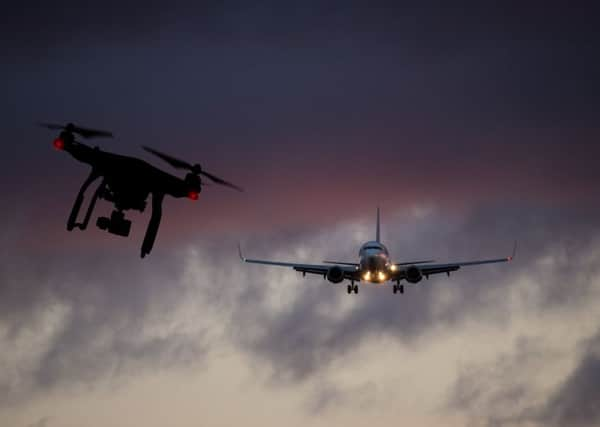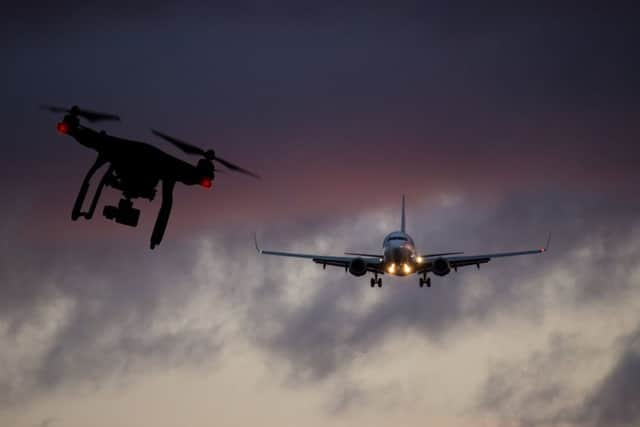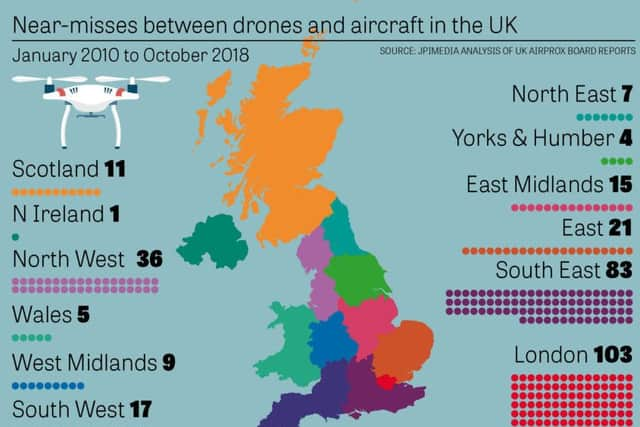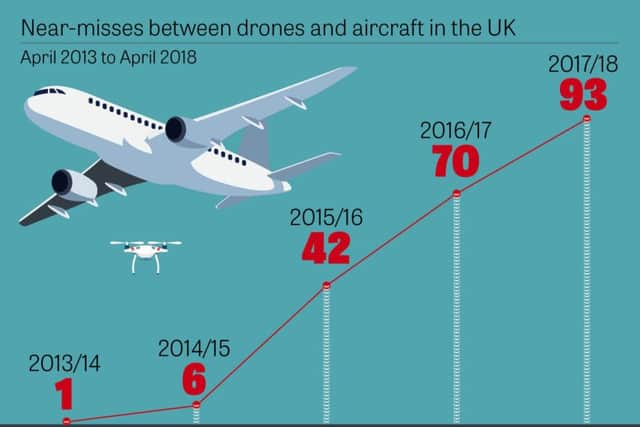11 near misses in Scotland between drones and aircraft, new analysis shows


An analysis of investigation reports shows Edinburgh Airport has been the Scottish hotspot, with five of the 11 cases north of the Border.
A further four were near Glasgow Airport.
Nearly half the Scottish incidents were rated as category A - the highest - where a “serious risk of collision existed”.


Advertisement
Hide AdAdvertisement
Hide AdA strike by a drone could break an aircraft’s windscreen or cause serious damage, the UK Government has warned.
There have not yet been any collisions between drones and aircraft in the UK, but at least seven incidents have been logged worldwide.
Edinburgh cases include a drone coming 75ft from an EasyJet Airbus A319 as it was descending to land in 2016.
The UK Airprox [Aircraft Proximity] Board, which investigates near misses, said a collision was “only avoided by providence”,


It reported: “The crew noticed it quite late, as it appeared in the 11 o’clock position and passed down the left side of the aircraft at the same level. The pilot noted that there was no time to take avoiding action.”
Drone sightings brought 36 hours of chaos to Gatwick Airport in the run-up to Christmas, with the runway closed and 1,000 flights affected in what police described as a “deliberate act” of disruption.
Heathrow was also forced to ground flights after drone sightings in early January.
However, pilots have reported narrowly missing flying drones since 2010, analysis of hundreds of official reports shows.


Advertisement
Hide AdAdvertisement
Hide AdSince the shutdowns, the UK Government has faced criticism that such incidents were foreseeable and more should have been done to prevent them.
But the Department for Transport said there are already laws against such malicious acts.
Aviation minister Baroness Sugg said: “The actions of these drone users were not only irresponsible, but illegal.
“The law could not be clearer that this is a criminal offence and anyone endangering others in this way faces imprisonment.
“Airports have measures in place to counter this threat.
Two-thirds of recorded incidents involved commercial passenger flights, with drones frequently being flown above regulatory height limits or within restricted airport zones.
However, the drone operators involved are rarely traced, UK Airprox Board documents show.
The board noted in one report that “the short battery life of drones means that, with a typical flying time of approximately 15 minutes, it is difficult for the police to respond and catch drone operators flouting the regulations”.
From last July, it became illegal for any drone to fly above 400ft. Despite that, more than 20 near misses above this height have been reported since.
Advertisement
Hide AdAdvertisement
Hide AdThe highest reported sighting of a drone by a pilot was at 15,500ft, nearly 40 times the legal maximum.
It came within 100ft of an Airbus 321 which had left from Doncaster Sheffield Airport on 3 June last year.
Jonathan Nicholson, of the Civil Aviation Authority, said: “There are some very clear reports from pilots where often drones have been flown well above 400ft.
“That is totally unacceptable and should not happen.”
Drones have grown rapidly in popularity in recent years and can now be bought for less than £20 on the high street.
July is the most common month for near misses and Sunday the most common day.
A spokesman for Edinburgh Airport said: “Drones pose a very real danger to aircraft – not just in the environs of the airport, but as they approach and depart.”
A spokesperson for Glasgow Airport said: “We remain vigilant and would remind people the use of drones within close proximity to an airport is both extremely dangerous and a criminal offence.”